Drought conditions continue to prevail across the local islands, in particular on St. Thomas and St. Croix. Record heat in most areas has intensified drought impacts.
However, improvements are possible during the next few weeks as a wetter pattern begins to occur across the northeast Caribbean.
Key Points
- Puerto Rico Conditions: In the past 60 days, most of northern, eastern, and southwestern Puerto Rico, as well as Vieques, has experienced 50%–90% of normal rainfall. Abnormally Dry (D0) conditions were reintroduced to most of these areas, while Moderate Drought (D1) conditions are now observed across the northeast, including the San Juan metro area, and a small portion of the northwest. The rainfall deficit for these areas ranges generally from 1–4 inches, but some areas in the northeast have been 6–12 inches below normal. Since June 1, San Juan has seen only 13.33 inches of rainfall, which is a deficit of nearly 10 inches. This is the driest such period since 1991. Normally, these should be some of the wettest months. Besides the dry conditions, record-high temperatures have prevailed as well across much of the island. September 2023 will easily end up as the warmest September on record, with an average temperature of 85.8°F through September 27. In fact, it may likely end up as the hottest month ever across the San Juan Metro Area. The current record is 85.7°F set in June 2012.
- U.S. Virgin Islands Conditions: Exceptional Drought (D4) conditions are prevailing across most of the U.S. Virgin Islands (USVI), with year-to-date (YTD) rainfall deficits exceeding 10 inches. Through September 27, Rohlsen Airport in St. Croix had only seen 11.35 inches of rain. This is less than 50% of the normal of 22.93 inches. This is the 2nd driest YTD on record, behind only 2015. Likewise, Cyril King Airport in St. Thomas had only seen 12.72 inches of rain YTD, which is also less than 50% of the normal of 26.5 inches. Besides the dry conditions, record heat has prevailed as well. September 2023 will end up as the warmest month ever on record at St. Croix, with an average temperature of 87.5°F through September 27, which will surpass the previous record of 86.7°F set just last month.
- Puerto Rico Impacts: The increasingly dry conditions are reducing soil moisture and negatively impacting vegetation, with signs of distress across the territory.
- U.S. Virgin Islands (USVI) Impacts: Drought continues to be a growing concern for many farmers and residents. Soil and vegetation in the USVI are visibly showing signs of distress, such as decreased soil moisture, and both livestock and poultry have been negatively impacted by the dry and hot conditions. Precautions such as ordering hay and water deliveries are being taken in some areas.
- Looking Ahead: The National Weather Service Climate Prediction Center's seasonal outlook calls for improvements.
- For weather information specific to your area, please monitor products issued by the National Weather Service in San Juan.
See below for additional details on rainfall, soil moisture, and streamflow conditions, impacts, and outlooks.
U.S. Drought Monitor map for Puerto Rico, as of September 26, 2023. The U.S. Drought Monitor is updated each Thursday to show the location and intensity of drought across the country.
The map uses 5 classifications: Abnormally Dry (D0), showing areas that may be going into or are coming out of drought, and four levels of drought (D1–D4).
U.S. Drought Monitor map for the U.S. Virgin Islands, as of September 26, 2023. The U.S. Drought Monitor is updated each Thursday to show the location and intensity of drought across the country.
The map uses 5 classifications: Abnormally Dry (D0), showing areas that may be going into or are coming out of drought, and four levels of drought (D1–D4).
U.S. Drought Monitor
D0 - Abnormally Dry
Abnormally Dry (D0) indicates a region that is going into or coming out of drought, according to the U.S. Drought Monitor. View typical impacts by state.
D1 – Moderate Drought
Moderate Drought (D1) is the first of four drought categories (D1–D4), according to the U.S. Drought Monitor. View typical impacts by state.
D2 – Severe Drought
Severe Drought (D2) is the second of four drought categories (D1–D4), according to the U.S. Drought Monitor. View typical impacts by state.
D3 – Extreme Drought
Extreme Drought (D3) is the third of four drought categories (D1–D4), according to the U.S. Drought Monitor. View typical impacts by state.
D4 – Exceptional Drought
Exceptional Drought (D4) is the most intense drought category, according to the U.S. Drought Monitor. View typical impacts by state.
U.S. Drought Monitor
D0 - Abnormally Dry
Abnormally Dry (D0) indicates a region that is going into or coming out of drought, according to the U.S. Drought Monitor. View typical impacts by state.
D1 – Moderate Drought
Moderate Drought (D1) is the first of four drought categories (D1–D4), according to the U.S. Drought Monitor. View typical impacts by state.
D2 – Severe Drought
Severe Drought (D2) is the second of four drought categories (D1–D4), according to the U.S. Drought Monitor. View typical impacts by state.
D3 – Extreme Drought
Extreme Drought (D3) is the third of four drought categories (D1–D4), according to the U.S. Drought Monitor. View typical impacts by state.
D4 – Exceptional Drought
Exceptional Drought (D4) is the most intense drought category, according to the U.S. Drought Monitor. View typical impacts by state.
U.S. Drought Monitor map for Puerto Rico, as of September 26, 2023. The U.S. Drought Monitor is updated each Thursday to show the location and intensity of drought across the country.
The map uses 5 classifications: Abnormally Dry (D0), showing areas that may be going into or are coming out of drought, and four levels of drought (D1–D4).
U.S. Drought Monitor map for the U.S. Virgin Islands, as of September 26, 2023. The U.S. Drought Monitor is updated each Thursday to show the location and intensity of drought across the country.
The map uses 5 classifications: Abnormally Dry (D0), showing areas that may be going into or are coming out of drought, and four levels of drought (D1–D4).
The U.S. Drought Monitor is updated weekly on Thursday morning, with data valid through that Tuesday at 7 am Eastern.
The U.S. Drought Monitor is updated weekly on Thursday morning, with data valid through that Tuesday at 7 am Eastern.
Current and Future Drought Conditions
Drought Conditions
- Puerto Rico: Around 47% of Puerto Rico is currently considered dry or in drought according to the U.S. Drought Monitor, with nearly 14% in Moderate Drought (D1).
- U.S. Virgin Islands: According to the U.S. Drought Monitor, Exceptional Drought (D4) conditions are prevailing across Saint Croix and Saint Thomas, while Saint John is observing Severe Drought (D2).
Sector Impacts
Agricultural Conditions
- Puerto Rico: Dry conditions have been constant and notable in the coastal northern region (Manatí) throughout September, although some rain did fall this week. Some areas have experienced dried or burned vegetation and forage, and some farmers have experienced smaller harvests. In the southern region (Juana Díaz and Coamo), landowners have experienced intense amounts of intermittent rain, and green pastures have been observed even in coastal areas. Farmers in the west region (Mayagüez) have experienced constant rain throughout the month. For farmers without an efficient irrigation system, this rain has been beneficial to the crops, but it has affected tasks such as plowing and land preparation. Farmers in the Southwest (Lajas, Cabo Rojo, San Germán) region have experienced some rain accompanied by excessive heat, which is affecting the vegetation. Vegetation and crops show stress symptoms even with rain. For farmers in the central mountainous area (Utuado, Adjuntas), rains in September have been experienced earlier compared to other years, when heavier showers were usually experienced in October. There have been few rain periods in September for the central eastern mountainous region (Cidra) compared to August. As for the eastern region (Gurabo, Carolina), dry periods in the summer and August prevented cropping and cultivation in early September. However, now that farmers have been experiencing short rain periods during the last two weeks that have not flooded or oversaturated the croplands, they are planning for land preparation. Short rain periods in addition to temperature increases have proliferated weed growth.
- St. Thomas: Farmers in St. Thomas are reporting that ponds are evaporating due to the high heat, but limited and sporadic rain is helping them recharge. High winds have reduced soil moisture. Many are still not planting due to drought and are working on land management practices to aid them during non-drought periods. Farmers are taking actions to plan and prepare irrigation and water efficiency tools to better manage water as part of longer-term mitigation and conservation plans. They are doing what they can to keep orchards and fruit trees watered at this time due to heat. Livestock farmers are rotating livestock and separating males and females to reduce births at this time due to a lack of forage on their land. Also, livestock farmers are buying grain and hay to ensure forage for their animals.
- St. John: Row- and specialty-crop farmers on St. John report some rain, with limited recovery from drought. However, high winds, excessive heat, and dry conditions continue to reduce soil moisture, which is impacting the farmers. Most are currently focusing on microgreens, fruit trees, and quick crops to keep production up and are rotating crops. Most are also preparing land for the upcoming rainy season, when they hope to increase production and make up for lost sales that were impacted during the current drought.
- St. Croix: Although sporadic rain has occurred, farmers are reporting that it is not penetrating the soil due to evaporation from high winds. Livestock farmers are working to plan for feed shortages later this summer due to a lack of grass during the hotter months.The USVI Department of Agriculture (VIDA) is currently buying and storing hay. Ranchers are exploring drought mitigation strategies to plan for vegetation distress and land management due to longer-term droughts in recent years. Losses of more than 200 livestock, along with 20 horses, have been reported since April, with an uptick from late May to the present. Poultry farmers are indicating that egg production has been reduced by more than 50% due to the heat. Poultry farmers also report they are concerned about conditions, as Ginney grass is sparse and chickens are not eating grain. Chickens are molting at this time, so production is still low, and the heat is still impacting them. Farmers who have poultry, including both broilers and/or egg production, have smaller numbers due to the fact they must collect water in containers or use cistern water for the poultry to have access to sufficient water during the extreme heat. VIDA on St. Croix reported that they provided more than 903,930 gallons of water to farmers in August and 1,097,690 gallons in September through the 27th.
- Assistance for USVI farmers and ranchers. According to the U.S. Department of Agriculture, St. Croix and St. Thomas already qualified for a 2023 secretarial drought disaster declaration, based on the U.S. Drought Monitor (USDM) depiction. Similarly, livestock producers in St. Croix and St. Thomas qualified for direct assistance through the USDM-driven Livestock Forage Program. LFP assistance begins when Severe Drought (D2) lasts 8 weeks or more, with payments tripling when the Extreme Drought (D3) threshold is reached and quadrupling upon spending 4 weeks at D3 or attaining Exceptional Drought (D4).
Rainfall Trends
Rainfall deficits across the northern slopes of Puerto Rico are ranging between 4–8 inches with isolated higher amounts (Figure 2). The San Juan Metro Area, which is a primary climate site, is experiencing below-normal rainfall as well, and now has a yearly deficit around 8 inches. Below-normal rainfall is observed across all climate areas except for the southern slopes of Puerto Rico (Figure 3). The past 60 days resulted in the removal of all drought across the southern part of the island. Some lingering rainfall deficits in the northwest coast contributed to continued Moderate to Severe Drought in this area (Figure 2).
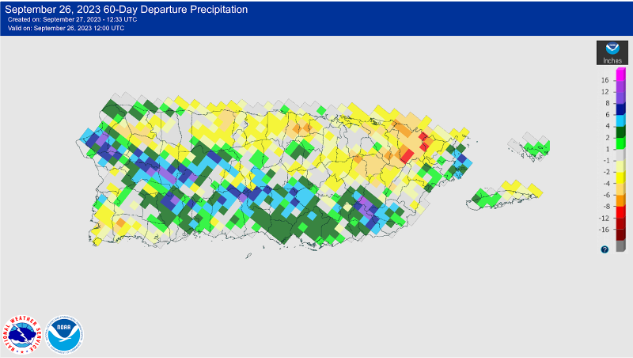
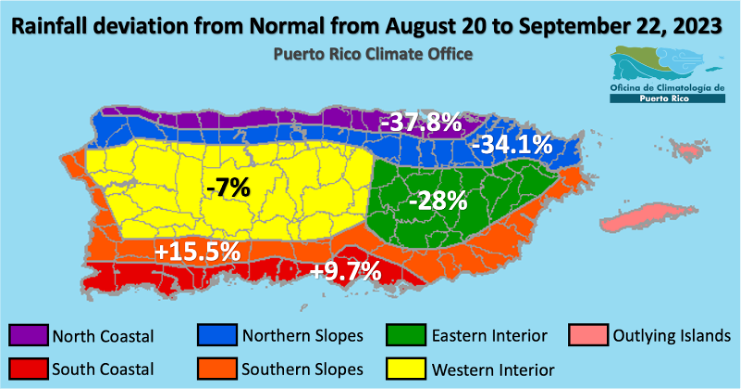
Soil Moisture Conditions in Puerto Rico
The latest soil moisture data from the Puerto Rico Agricultural Water Management (PRAGWATER) indicates dry soils across the southern slopes and northwest Puerto Rico, as well as portions of the eastern interior (Figure 3). This is resulting in extreme crop stress across these areas (Figure 4).
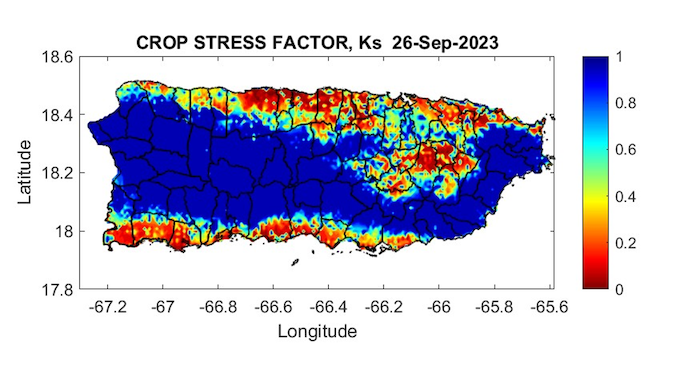
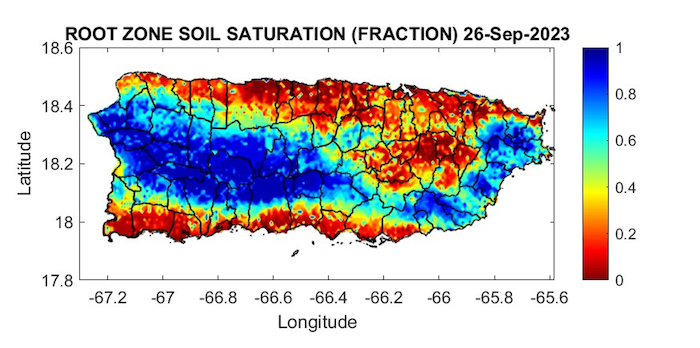
Streamflow and Reservoir Conditions in Puerto Rico
The real-time 28-day average streamflow from the U.S. Geological Survey (USGS) river gauge network (Figure 5) indicates most rivers and streamflows across eastern and the western interior of Puerto Rico are running below or well below normal. Rivers in the central interior and south are running near normal. View more information on groundwater levels along the South Coast of Puerto Rico.
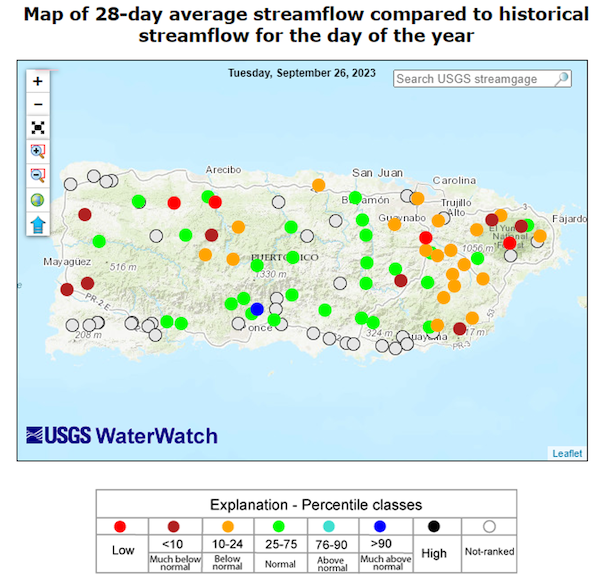
Outlooks
Seasonal Drought Outlook
Seasonal drought outlooks call for improvements across the local islands (Figure 6). Climatologically speaking, September, October, and November are the wettest three consecutive months of the year at both St. Croix and St. Thomas, with average rainfall of 15–18 inches, respectively. November is the wettest month of the year for San Juan, with nearly 7.5 inches of rain on average. Thus, even only near-normal rainfall in all these locations would result in drought improvements.
The next week looks quite wet, as Tropical Storm Philippe stays east of the Greater Antilles. This should result in unsettled conditions, and above-average rainfall, with rather widespread 2-inch totals expected over the next week for the USVI and Puerto Rico, with locally higher amounts.
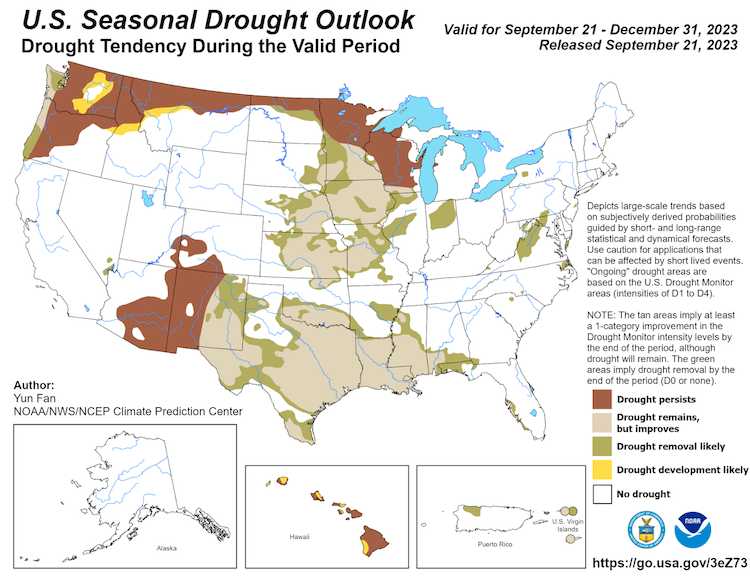
For More Information
- National Weather Service (NWS) Weather Forecast Office – San Juan: Climate and Drought Information
- NWS Drought Information Statements for Puerto Rico and the U.S. Caribbean
- Drought.gov:
- Caribbean Drought Bulletins. Caribbean Regional Climate Center, Caribbean Institute for Meteorology and Hydrology (CIMH), Barbados
- U.S. Department of Agriculture (USDA) Caribbean Climate Hub drought and disaster assistance resources for tropical forestry and agriculture
Prepared By
Odalys Martinez and Emanuel Rodriguez
National Weather Service Weather Forecast Office – San Juan
Héctor J. Jiménez
Office of Climatology, University of Puerto Rico
Meredith Muth
NOAA/National Integrated Drought Information System (NIDIS)
Victor Murphy
National Weather Service Southern Region
Christina Chanes
University of Virgin Islands
Silmarie Crespo Vélez and Nora Álvarez-Berríos
USDA Caribbean Climate Hub, USFS International Institute of Tropical Forestry
Brad Rippey
USDA Office of the Chief Economist
Timothy Dalrymple
USGS Caribbean - Florida Water Science Center (CFWSC)
Puerto Rico Reporting Input: Thanks to the Agricultural Extension Service, College of Agricultural Sciences, University of Puerto Rico-Mayaguez. Special thanks to Dr. Luis Alexis Rodríguez-Cruz, Dr. Diana Guzmán-Colón, agronomists and farmers: Gabriela Álvarez, Merari Torres Amaro, Miguel Rosario-Torres, Darianna Mattei, Diego Sotomayor, Sebastián Diaz, Fernando Figueroa, and others.
USVI Reporting Input: Several individuals contributed to this report, and we acknowledge the following for their support, including the farming community across the USVI, UVI faculty, staff, and collaborators of the UVI School of Agriculture, UVI Physics Program, UVI Etelman Observatory, UVI Agricultural Experiment Station, VI Department of Agriculture, as well as the USDA Office of the Chief Economist, National Parks Service in St. Croix, VI Department of Planning and Natural Resources, USDA Farm Service Agency, Coral Bay Community Council, and the many volunteer drought reporters and farmers from across the territory.
About This Report
This drought update is issued in partnership between the National Integrated Drought Information System (NIDIS), National Oceanic and Atmospheric Administration (NOAA) National Weather Service, the U.S. Department of Agriculture (USDA), and the University of the Virgin Islands. The purpose of the update is to communicate a potential area of concern for drought expansion and/or development within Puerto Rico and the U.S. Virgin Islands based on recent conditions and the upcoming three-month forecast.
NIDIS and its partners will issue these updates every two months. Subscribe for these U.S. Caribbean drought updates here.







